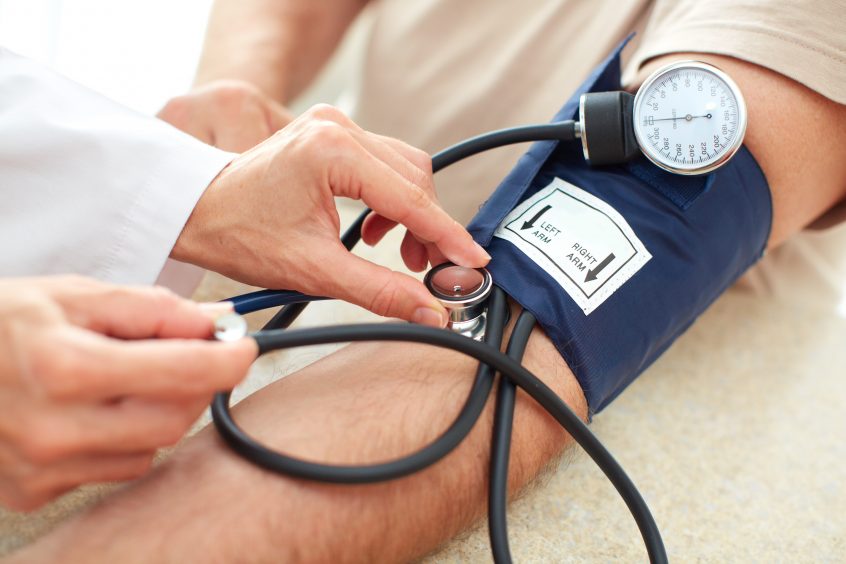Part of a routine doctor’s visit is to have your blood pressure checked. The nurse straps your arm, puts a stethoscope to your artery, pumps up the balloon, and says some numbers.
90/60, 120/80, or 130/80
Then the nurse says something like “seems a little high today” or “perfect” and goes about jotting it down in your chart.
While you may be sitting there scratching your head at those numbers, your doctors is taking note of them to determine your risk factors for heart disease, stroke, kidney disease, and other health problems.
So what do these numbers actually mean and how can they help determine your risk for deadly diseases?
Blood pressure is determined by the amount of blood pumped by your heart and the ease at which it flows through the arteries.
The top number is called Systolic Pressure. This is the amount of pressure your heart exerts when pumping blood through your arteries to the rest of your body.
The bottom number is Diastolic Pressure. This refers to the amount of pressure in your arteries when your heart is at rest between beats.
Throughout the day, blood pressure varies, depending on body position, breathing rhythm, stress level, physical activity, medications you take, what you eat and drink, and time of day. Blood pressure is usually lowest at night when your body is at rest and rises on waking.
A normal blood pressure reading is 120/80. This is the sweet spot and where you want to try to stay. It means your heart is pumping the right amount of pressure and you are getting the right blood flow through your arteries to the rest of your body.
What is Low Blood Pressure?
A blood pressure reading lower than 90/60 is generally considered low blood pressure (hypotension). Low blood pressure might seem desirable and for some people, it may cause no problems, however, for the vast majority, low blood pressure can cause dizziness and fainting. In severe cases, it can be life-threatening.
The causes of low blood pressure can range from dehydration to serious medical or surgical disorders. It’s important to find out what’s causing your low blood pressure so that it can be treated.
Symptoms
For some people, low blood pressure can reflect an underlying problem, especially when it drops suddenly or is accompanied by signs and symptoms such as:
- Dizziness or lightheadedness
- Fainting
- Blurred vision
- Nausea
- Fatigue
- Lack of concentration
If it drops low enough it could cause extreme hypotension, a life-threatening condition. Signs and symptoms include:
- Confusion, especially in older people
- Cold, clammy, pale skin
- Rapid, shallow breathing
- Weak and rapid pulse
Conditions that can cause low blood pressure
Pregnancy. Since the circulatory system is expanding rapidly it can cause blood pressure to drop
Heart Problems. This includes low heart rate, heart valve problems, heart attack, heart failure
Endocrine Problems. Examples include parathyroid disease, adrenal insuffciency, low blood sugar
- Dehydration
- Blood Loss
- Severe Infection
- Lack of nutrient in your diet
- Certain medications
What is High Blood Pressure?
High blood pressure is a common condition in which the long-term force of the blood against your artery walls is high enough that it may eventually cause health problems, such as heart disease. It generally develops over many years, and it affects nearly everyone at some point. Fortunately, high blood pressure can be easily detected. And once you know you have high blood pressure, you can work with your doctor to control it.
While you can have high blood pressure (hypertension) for years without any symptoms, it can still cause damage to blood vessels and your heart. Additionally, uncontrolled high blood pressure increases your risk of serious health problems, including heart attack and stroke.
According to the American Heart Association, more than 121 million adults had cardiovascular disease in 2016. Taking out those with only high blood pressure leaves only 24 million, or 9% of adults, who have other forms of disease such as heart failure or clogged arteries.
In fact, high blood pressure has played such a major role in heart disease that in 2017 it was decided to change the high blood pressure reading from 140/90 to 130/80. This was done to allow those at risk to get help before their risk for heart attacks, strokes, and many other problems increases beyond control. However, only about half of those with the condition have it under control. Read more…
Symptoms
Many symptoms of high blood pressure may not show until your blood pressure is dangerously high. If you have a family history of high blood pressure it would be beneficial to understand the possible symptoms, as it could be genetic. People with high blood pressure might have symptoms that include:
- Headaches
- Shortness of breath
- Nosebleeds
- Chest pain
- Visual problems
- izziness
Certain factors can cause a temporary rise in blood pressure such as:
- Stress or anxiety
- Cold temperature
- Exercise
- Smoking
- Caffeine
- A full bladder
If you experience these symptoms it is important to seek medical care as soon as possible. Untreated and uncontrolled high blood pressure can damage your blood vessels and other organs, including your eyes, kidney, heart, and brain.
Ways to get your blood pressure down –
- More physical activity (if you have a health condition discuss your physical exercise with a doctor before starting)
- Less salty foods
- Lose weight if you are obese/overweight
- Decrease/eliminate alcoholic beverages
- In some cases, blood pressure medication is prescribed
Complications
The excessive pressure on your artery walls caused by high blood pressure can damage your blood vessels and organs in your body. The higher your blood pressure and the longer it goes uncontrolled, the greater the damage.
Uncontrolled high blood pressure can lead to complications including:
- Heart attack or stroke
- An aneurysm
- Heart failure
- Weakened and narrowed blood vessels in your kidneys
- Thickened, narrowed or torn blood vessels in the eyes
- Metabolic syndrome
- Trouble with memory or understanding
- Dementia
For a more accurate reading:
- If you take your blood pressure at home find a quiet location, and try to remain calm and relaxed.
- Don’t exercise, smoke, or have caffeine 30 minutes before measuring your blood pressure.
- It’s best to vary times of day that you take your pressure readings to see the range of your blood pressure. Blood pressure monitoring is a great way to begin to better understand your body.
It is sad to say, but 1 in every 3 adults in the United States have high blood pressure. That equals out to just over 100 million adults in the United States. The risks associated with high blood pressure are too extreme to ignore. Make sure to ask the right questions and do your very best to understand what your body is trying to tell you.
If you are at all concerned with your heart health you should consider getting a Heart Scan at Advanced Body Scan in Oklahoma City or North Texas. The best prevention of cancer and heart disease is to catch them inside your body before they show up as outward symptoms. Advanced Body Scan has the technology to do just that.
If you are someone worried about your family history or are just desiring peace of mind in regards to your health, please consider coming to our facility and getting a heart and lung scan today. One scan could save your life.
If you think that you may be experiencing any of the signs or symptoms highlighted in this article regarding high blood pressure or low blood pressure, please do not wait. Call or visit your nearest hospital immediately. It is imperative to take the warning signs seriously.

